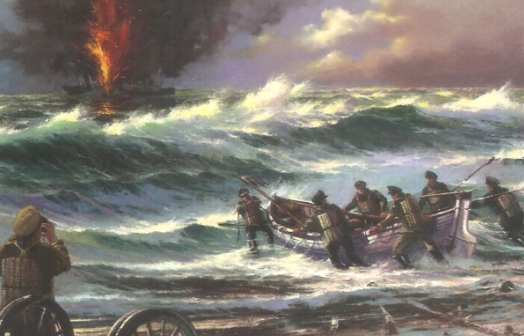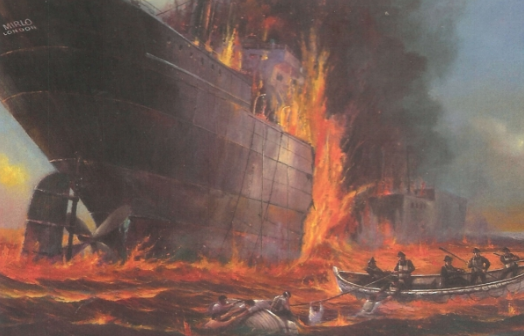When a German torpedo struck the British Tanker Mirlo in the afternoon of August 16, 1918 off the coast of Rodanthe on the Outer Banks, the world of the 52 merchant seamen on board became an inferno of oil-fed flames. The fact that 42 of the crew survived was a miracle of the sea.

The 6,679-ton tanker was filled with gasoline and refined oil products, sailing from New Orleans to London. It traveled close to the Outer Banks as it used the power of the Gulf Stream to make the trip faster and to save fuel.
The Germans knew the trajectory of the ship, and as the Kaiser’s U-boats had been seen lurking offshore the allied ships were on high alert.
Under the command of Kapitanleutnant Otto Droscher, U-117 was tasked with laying mines in shipping lanes and attacking shipping as warranted. The submarine had enjoyed a tremendously successful cruise before encountering the Mirlo. She had already sent 13 victims to the bottom of the sea, although nine of those were fishing ships she stumbled upon on August 10.
On August 16, at approximately 4:40 p.m. the Mirlo passed 425 yards from U-117, and Kapitanleutnant Droscher fired one torpedo, striking the ship squarely amidship.
Seven miles away, at Chicamacomico Lifesaving Station in Rodanthe, Surfman No 8 Leroy Migett was on watch. He reported seeing a column of water fly into the air when the torpedo struck.
On the Mirlo, Ship’s Captain William Roose Williams first tried to ground his ship, but quickly realized his ship was doomed and ordered the crew to lifeboats.
The first lifeboat became fouled in the lines as it dropped to the water, spilling the 15 crew members. Desperately, the men clung to the gunwales of the overturned boat, but as the boat drifted in the sea, the flames from the gasoline floating on the water came ever closer to the boat.
The two other lifeboats launched successfully, but they were so overloaded that they, too, were in danger of sinking.
On shore, Station Keeper John Allen Midgett lost no time. As soon as the report came that the ship had been struck, he ordered his crew (made up mostly of relatives) to hitch the station’s horse to the wagon and haul the motorized lifeboat to the surf.

By 5:00 p.m., the crew was ready to launch, but the sea was rising. It took four attempts to get the boat past the breakers.
Captain Williams’ lifeboat had 16 men in it, and whether through good seamanship or luck, he was able to row clear of the inferno and his boat was the first that Station Keeper Midgett encountered.
Seeing that the boat was well-handled and under control, Midgett told Williams to take the craft to the breakers but wait for the Coast Guard to lead him in.
Meanwhile, a tremendous explosion ripped the Mirlo in two, spewing flames and more gasoline into the waters.
Inside the conflagration, a second lifeboat with 19 men aboard drifted aimlessly, the boat so overloaded that no one could man the oars. Heat and exhaustion were taking a toll on the men clinging to the capsized boat, and one by one they slipped beneath the waters.
The Coast Guard crew entered into the fiery hell and made for the capsized boat. It was not seen at first, hidden by black smoke and flames. Spotted by the bow of the remains of the Mirlo, to get to the craft, the Chicamacomico crew had to cross burning water to get to it. It was so hot, the paint on the boat blistered.
The men covered their faces with wet shirts and used oars to push pools of flaming gas and oil away from their boat. Their efforts were rewarded as six burned, exhausted sailors were plucked from the water.
Now, the search began for the missing lifeboat, drifting helplessly amid the flames and wreckage. The sea and the wind were rising and daylight fading.
It is possible that the rising sea had saved the lives of the crewmen in the third lifeboat; although the boat had drifted through the heart of the cauldron, the rough conditions splashed just enough water on board to keep the flames at bay.
Now, though, the wind was working against the boat. Unable to power the craft with oars, it was at the mercy of the wind and was being pushed steadily to the south. Ocean conditions were deteriorating and the men were frantically bailing to keep the boat afloat.
When Midgett and his motorized craft located them, the boat had drifted two miles south of the Mirlo. Attaching a line to the lifeboat, the boat was towed to where the other British lifeboat was waiting just beyond the breakers.

The surf had been rising all day, and by the time the crews gathered, waves were reported to be over 15’. Midgett knew of a bar that would give some protection from the waves, and by ferrying the Mirlo crew 10 at a time, by 9:00 p.m. everyone was ashore.
The Mirlo rescue is considered one of the most remarkable in Coast Guard history. The British government awarded the crew of the motorized launch their Gold Lifesaving Medals for “Gallantry and Humanity in Saving Life at Sea.” The Coast Guard awarded each member of launch the Gold Lifesaving Medals of Honor, and later Grand Crosses of the American Cross of Honor.
